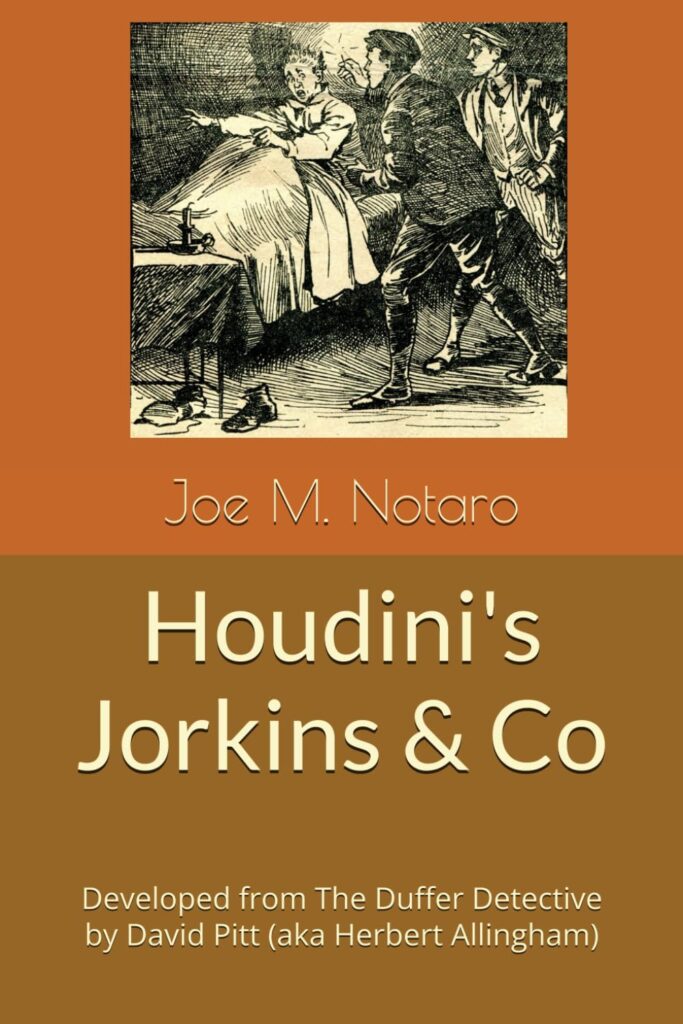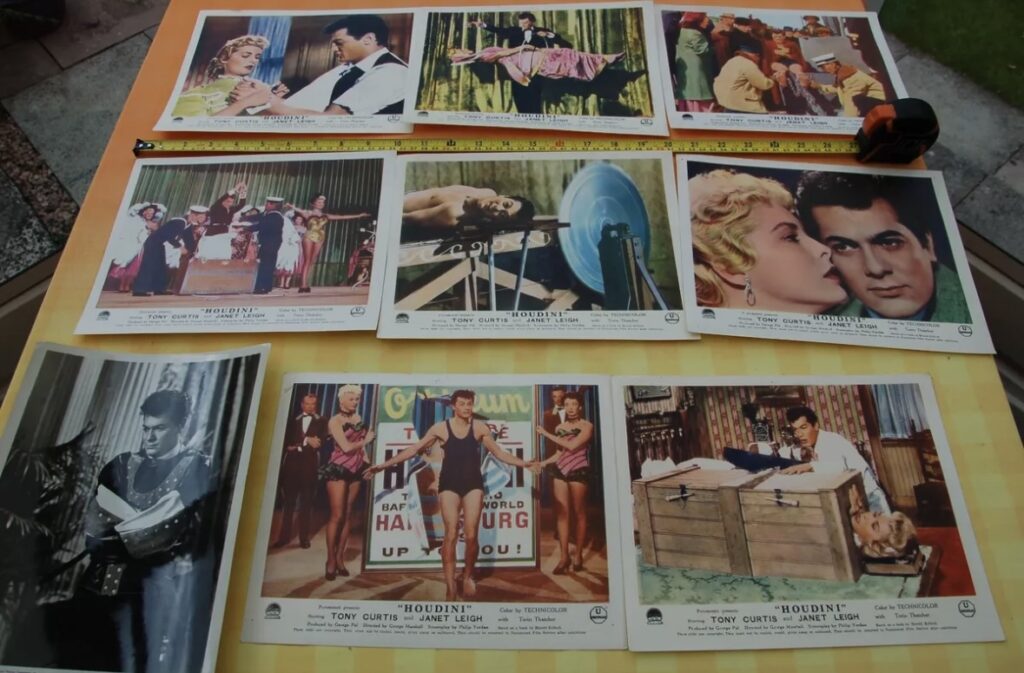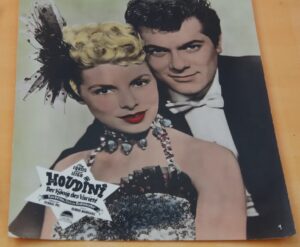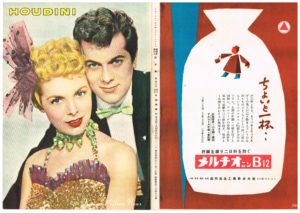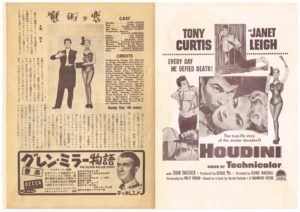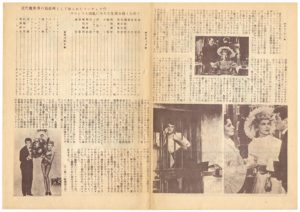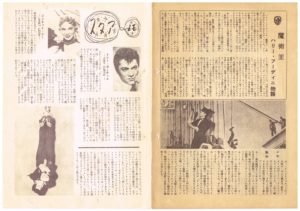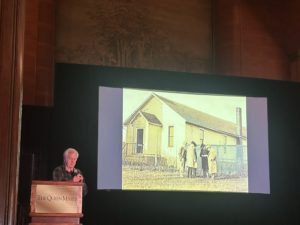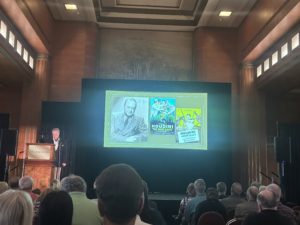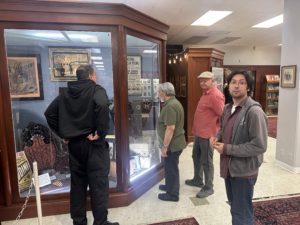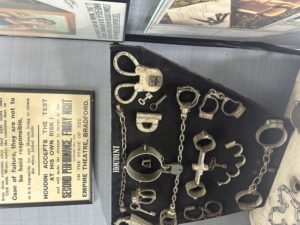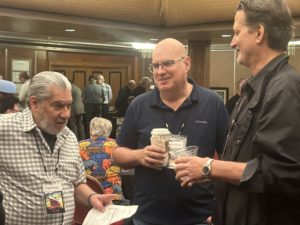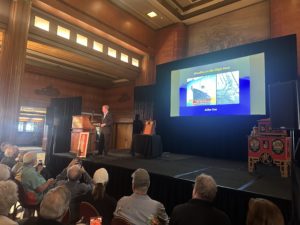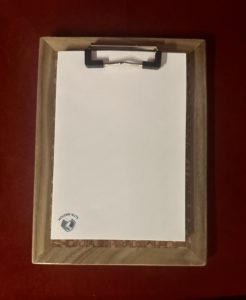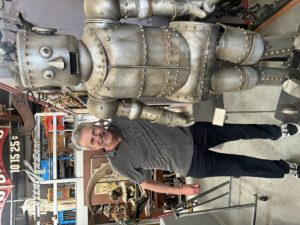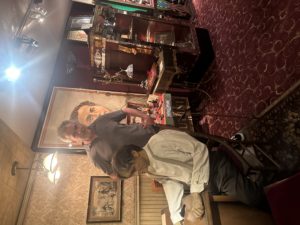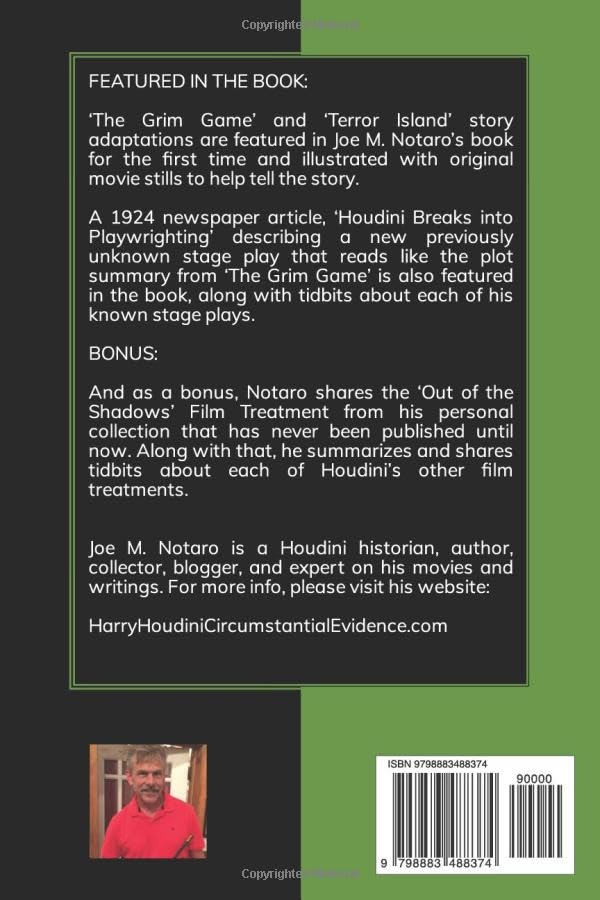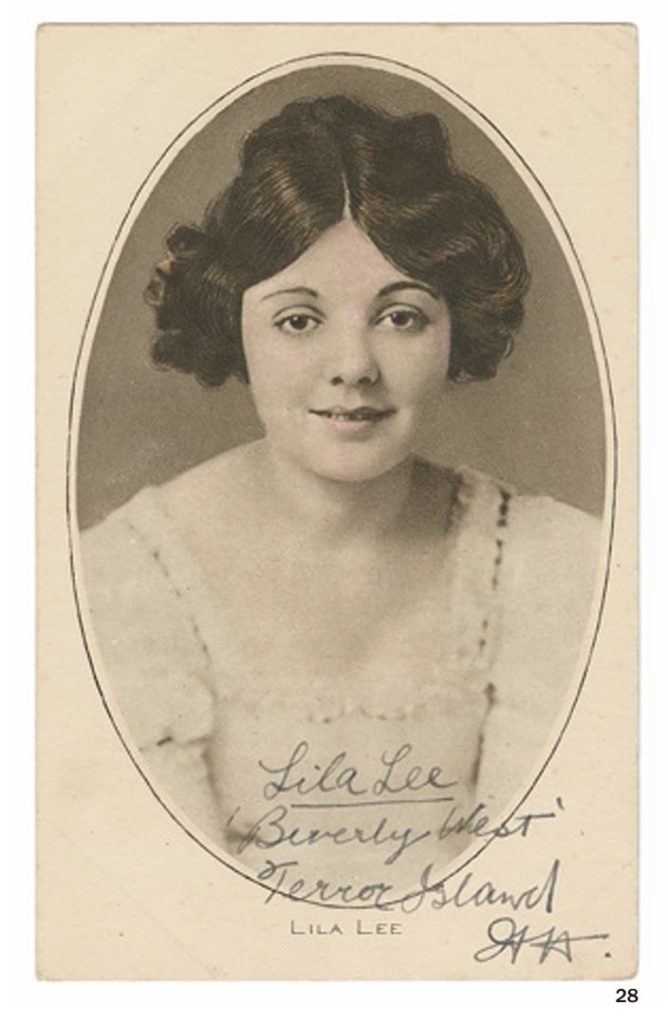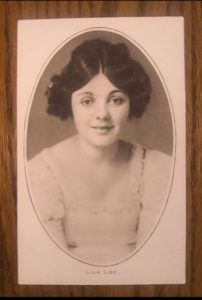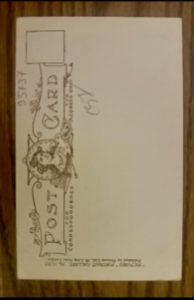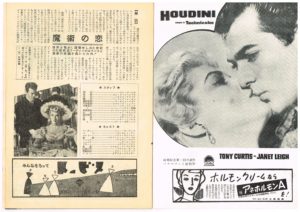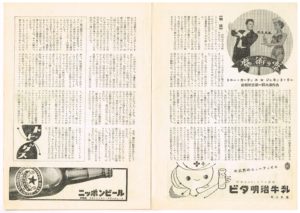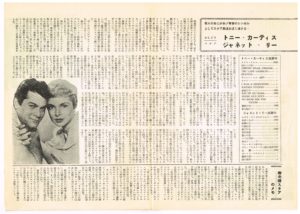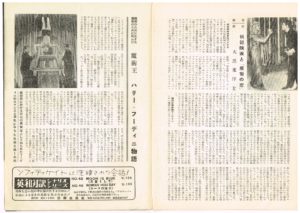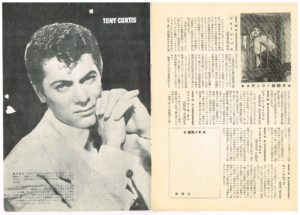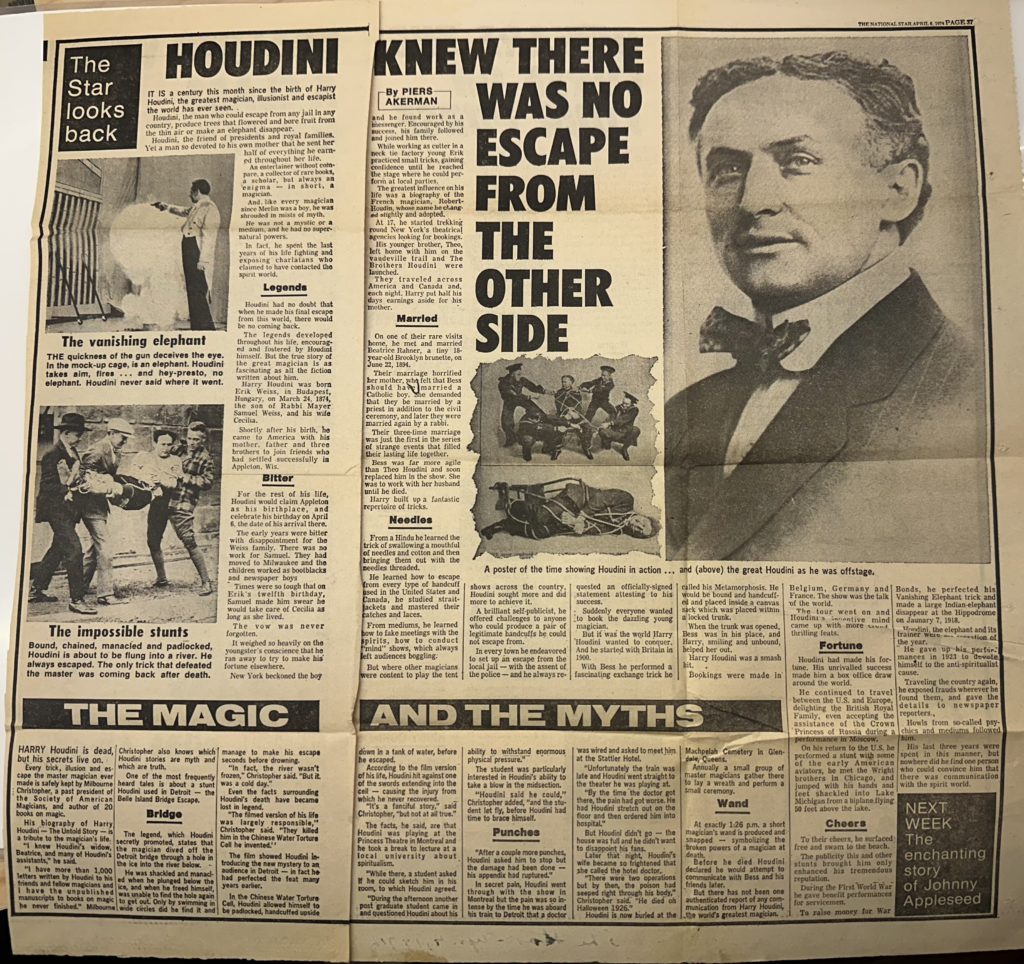In 1950, Film Producers, Inc was going to make a Houdini Pic. They commissioned a 150-page screenplay (June 25, 1950) by Stephen Longstreet which led to a 172-page screenplay by Endre Bohem and Hilda Gordon (August 29, 1950).
In June of 2019, I did a post that summarized the 172-page screenplay dated August 29, 1950
A week after that post, I returned to the Margaret Herrick Library to do some more research.
Below are my notes from 2019 on the 150 page screenplay which I think readers will find fascinating:
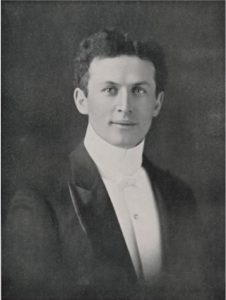
HARRY HOUDINI [Age 32] April 6, 1874 – October 31, 1926
Halloween night, kids dressed in costume approach Houdini House
A big room filled with many books and posters. Bess, a middle-aged woman with graying hair. By her side ED CONDON, an aging man showing the scars of forty years of show business. They are looking at a tall clock, its hands at ten to twelve. Picture over clock, a large photograph of HH in his prime. The strong face, the eager eyes, the full firm mouth stare out at us showing the full power of this fine human being. Under the frame are the words: HARRY HOUDINI April 6, 1874 – October 31, 1926
Under the picture stands an etched colored glass cup of rare workmanship. On it are carved magic symbols and the figure of a wizard.
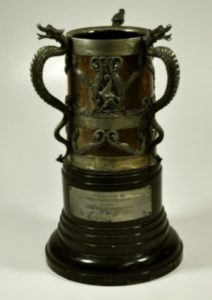
Houdini Dragon Cup Award 1908
Page 2: Between them on a small table is a letter sealed and taped with red ribbon. In nine minutes it will be just one year since he passed over. Bess picks up the letter: He left this letter to us in his will, His wife and manager. If he can come back to us from the grave, he would do it on Halloween night, at twelve.
Ed: And you think he’ll repeat the code words in that sealed envelope., Bess?
Bess: We’ll soon know…
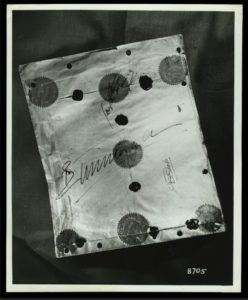
Sealed Envelope [Houdini Magical Hall of Fame]
Ed: If anyone can do it Bess, Houdini will. He didn’t ever give up and it was a tough, long road. From a kid full of tricks, from the middle west, to becoming the Great Houdini. But he was always a mystery to me. I can’t say super-natural, but something like it. Even the first time I met him, I felt it. Back in 1900…
Page 9: Biff Brown riding a bike and Della in tights, Biff falls and tears pants, HH has sewing needles/thread and does needle trick 200 needles, fifty yards of thread
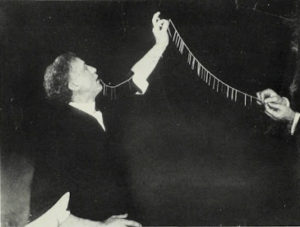
HH then does empty glass to milk then wine and customers all rush the stage with empty glasses and he pours different color drinks and then pulls an American flag out of the bottle.
Page 15: HH started picking up handkerchiefs with his eyelids while hanging from a ponies neck. HH produces a cigar for Biff and flowers for Della
Page 20: Show at Beer Garden, Biff and Ed do a pretty fair juggling act, but nothing out of the world … They toss plates and balls around. Suddenly Houdini appears and begins to catch the plates. He makes them appear and disappear at will. He then makes ducks appear out of an empty tub.
REEGEN PARTY As they clap hands over tricks. Bess is very excited, How does he do it? Mr. Reegan says with mirrors I hear. Houdini leans over footlights and speaks to Bess. “That’s right little lady. No mirrors. Will you please step up and inspect the stage. Please.”
Houdini goes to a small table and picks up two beakers filled with some colored smoking chemicals…
A drunk in the front row picks up a pretzel and throws it at Houdini…
The pretzel hits Houdini’s arm and he spills a red chemical over Bess’s dress. Houdini tries to take it right out with the magic likker, and the magic word and pours the chemical over the dress but it only makes it worse.
Page 26: Houdini delivers the dress without a stain to Bess thanks to his mama putting in a new panel
Page 27: Bess and Houdini go to Coney Island
Page 28: Asks Bess to marry him
Page 36: HH gives Bess tights and performs Metamorphosis
Page 40: Sheriff’s hand as he nails a writ of attachment onto a car of the tent show with the butt of his pistol. The show folk, Houdini, Della, Bess, Biff, and Ed watching. The long train is ready to go, but now it looks like it’s going nowhere.
SHERIFF: Just remember – this here show stays right here until somebody pays for the damage to Mr. Nelson’s field.
BIFF: Look we paid the old skinflint for the rent of it… It’s a holdup.
HOUDINI: We’re a mile from the state line. When I give you the nod have the engineer let her roll.
SHERIFF: You try and start this train and see if I aint a dead shot that kills people.
HOUDINI: (taking gun from sheriff and examining it) Sure is a beauty isn’t she? (sights it and twirls cylinders) I used to catch these slugs in my teeth at twenty yards. Great act.
SHERIFF: Fella, you must be a real damn fool.
HOUDINI: (handling pistol to Sheriff. Well, let’s see how good you are. I’ll catch all you fire at me in my teeth.
SHERIFF: Suicide if I every saw it.
ED: As he signals the engineer to stand ready.
Houdini takes his place twenty yards from the sheriff.
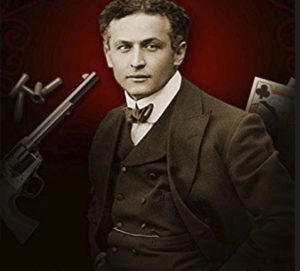
Coffeyville Cover
Page 42: HOUDINI: Ready?
SHERIFF: Fella, ready as I’ll ever be. I hope they let Yankees into Heaven. Here goes!
Then see Houdini picking a slug from his teeth after Sheriff fires.
HOUDINI: See nothing to it. Try it again?
SHEFIFF: I still don’t believe it… fires
HOUDINI: (picking slug from between his teeth and walking over to sheriff). Let’s make it a little harder.
Houdini takes the sheriff’s handcuffs out of his pocket and holds them up.
HOUDINI: Now put your cuffs on me and I’ll show how to open any of them with a trick twist.
Page 43: Sheriff snaps cuffs on Houdini and tells him he will never get out of them.
Houdini tapping cuffs, they spring open. It’s all the way you tap them. (snaps them on sheriff through the iron gate so that sheriff is fastened to gate.
Ed signals the engineer…
Page 44: BESS: You never did that gun trick before. BIFF: Wasn’t dangerous? Houdini: It was getting dangerous, if he had fired a third shot. I didn’t have time to slip in more than two blanks.
Pages 47: plus: Houdini secures a vaudeville gig by impressing a manager (Corey) with paper bag escape, but is at the bottom of the bill.
Page 55: The sign reads: THE GREAT HOUDINI ON SATURDAY MORNING WILL BE HANDCUFFED NAILED INTO A PACKING CASE, DROPPED THROUGH A HOLE IN THE ICE UNDER THE STATE STREET BRIDGE AND WILL FREE HIMSELF IN THREE MINUTES.
Page 63: Houdini bumping against ice, failing to find hole. He sinks, comes up – gulps a little air – again fails to find hole and sinks again…Four minutes two seconds, get the grappling hooks, suddenly the body of Houdini shoots to the surface of the water.
STRAITJACKET ESCAPE
SCOTLAND YARD
ENGLISH PRISON
Page 81: Houdini Hotel room in Rome, Italy, A copper coffin stands on legs in the big living room of the suite. Houdini is walking around it making notes.
Pages 82 to 91 are missing
Page 93: Houdini’s dressing room. The old man Holtz picks up a small leather covered case and opens it. In it is the wizard cup, a glass cup carved with many magic symbols and the picture of a wizard. Holts holds this towards Houdini. I want you to have this. It’s a famous old glass called the wizards cup. It was given me by the king himself. It’s very old…very, very old…
HOUDINI: It’s much too valuable for me.
HOLTZ: It was made by a secret glass formula no longer known by certain wizards of olden times. They say that when the glass was melted to make this cup the heart of the great wizard Faust von Landsberg was thrown into the vat and this cup made.
HOUDINI: Its very beautiful…
HOLTZ: They say that when a new wizard appears and performs the most supernatural feet ever done on this earth the cup will know and change colors…I say you are going to be such a one among us…
HOUDINI: You don’t have to say anything. It’s good to have you back stage.
HOLTZ: I’ve just been to my lawyers. I’ve made my will…A man grows older. My library, my pictures, my tricks…even Willie here (the dog barks). See he likes the idea of going to America.
Houdini sits down to face the old man, takes his hand in his: you mustn’t talk that way HOrr Holtz. We makers of magic have many tricks and some of them is to fool death itself.
HOLTZ: You’re still thinking of that casket business. Burial alive?
HOUDINI: I’m going to perform it some day.
HOLTZ: I have the book, you saw it…that tells of it…But it’s very dangerous – very dangerous…I never dared try it myself.
HOUDINI: I’m on in a minute. You sit here, rest, I’ll be back soon. We’ll talk…Bye Willie
He goes out, the dog wags his tail…Holtz looks down at the dog. Young alive isn’t he? You should have seen me in those days, Willie, when I was like that. How they used to cheer and the honors. And the Prince himself coming around afterwards. And the women, all the wonderful women, the dressing room smelled like a rose garden. And I was the King of Magic…like he is now.
Page 96: Holtz is dead.
Houdini returns to new home in New York
Page 101: A wooden packing case in the shape of a coffin.
Houdini: I wish I had the real one for the big tour.
ED: It’s going to take two months to build the bronze casket this size and shape. Anyway you can’t control your breathing for four hours buried alive.
BIFF: No future in the trick anyway.
HOUDINI: I hear you don’t think there’s any future in my whole act.
Page 103: Mama tells Houdini: Don’t try the casket trick, Harry. I worry over you. You don’t know, but when you’re away I have a feeling I know what’s happening to you. Sometimes I used to scream in my sleep and wake up…and later I’d find out you were trying a new trick…
HOUDINI: Don’t worry over the trick Mama. I’ m not ready for it yet…
MAMA: Come home soon Harry. In the spring everything is so green here.
HOUDINI: I’ll be back with the spring onions, Mama…
Page 104: Willie comes into the scene, stands up on hind legs and we he’s wearing a small set of handcuffs.
HOUDINI: I’m tires of being challenged by every local blacksmith. Now when that happens I let Willie do the escape. As he shakes cuffs off his legs and takes a bow.

Bobby – Houdini’s Dog that escaped cuffs
Page 105: Houdini and Bess in heavy fur coats are standing backstage watching eight men stagger in with a bronze casket. Ed is directing them.
Page 106: The stage is full of chairs. Houdini is sitting on the coffin facing some professors and newspaper men.
HOUDINI: I don’t make a claim, I prove things. I have discovered the secret of ancient temple miracles. The high priests were buried alive in air tight caskets and later were dug up and survived.
PROFESSOR: You believe this nonsense?
HOUDINI: I intend to duplicate it. At ten o’clock tomorrow afternoon I intend to be sealed in this bronze casket at the edge of Carlson Park, buried in a six foot grave and I will remain in it until two o’clock, at which time I will come out alive, leave the casket and come out of my grave, all unassisted.
REPORTERS: Wow! What a story! Is that the truth!
HOUDINI: The sealed casket will remain on display in the theatre lobby all day in a tank of water to prove its air tight. I invite the professors tomorrow to secure down the lid on themselves.
PROFESSOR: Very well. But I doubt the scientific value of this… I doubt the whole thing.
HOUDINI: Bows and smiles.
Page 110: Houdini has never been buried alive for four hours and seven minutes. He should appear soon.
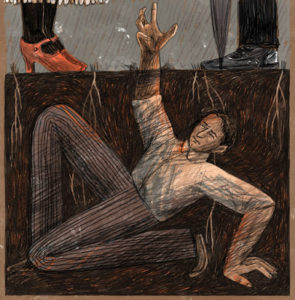
Noa Kelner Buried Alive Illustration
Page 111: The earth in the grave is stirring…at last a hand comes out, struggles, opens and closes then stops. There is no more movement from the grave, only this stiff hand is seen.
Everyone steps back but Ed and Bess. They fling themselves on the grave and begin to dig…Willie helps.
ED: Come on! Everybody dig!
Everyone begins to dig around the stiff hand. Soon they have exposed Houdini’s face. He has fainted, or is dead. Anyway he shows no sign of life…
Bess takes Houdini’s head in her lap and sobs. Harry Harry speak to me.
Bells of an ambulance are heard.
Houdini’s body is now freed of the grave. Bess, Ed and some men lift it and rush it to the waiting ambulance.
Page 115: Houdini opens his eyes and looks around him. Bess rushes to his side, takes his hand.
HOUDINI: Mama is dead…isn’t she?
BESS: You knew before we, didn’t you?
Houdini staring up at the ceiling, she told me she was going…she told me that night I tried to reach her ….She called me. I tried to find her grave later. But I couldn’t get to her…I failed her…
Page 120: Houdini being screwed into casket and casket being lowered into pool as crowd watches. There are no air bubbles.
Buffalo Theatre poster reads: “HOUDINI” IN AN ALL NEW SHOW FEATURING BURIAL ALIVE!

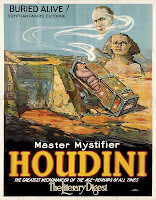
Page 123: Houdini: Wouldn’t it be wonderful if we could make contact? It would bring mama close again.
Houdini exposes Madame Jarronda as Biff tries to find Della who died.
Page 129: King the publisher of Scientific Nature’s Magazine and his four editors have found a woman, Mrs. Felton, who has made contact, but Houdini to test Mrs. Felton.
Page 138: HOUDINI: I regret to say Mrs. Felton made non real contact with the dead.
Page 139: Houdini offers $75,000 to any spiritualist who can baffle him.
Page 149: HOUDINI: My biggest and best trick. One little detail yet Bess to work out, but it’s coming to me clearer and clearer…We’ll tour the world with it… (suddenly he closes his eyes — opens them, tries to sit up and shouts I’m coming Mama!
He falls back, eyes closed. Dead…
As Bess falls to her knees weeping.
Page 150. Houdini’s Library Living Room- 1927
We are back in our opening scene. The clock is striking twelve. Bess and Ed as old people are watching it…the sealed envelope is on the tray between them…
There is tapping in the French window. Bess and Ed turn to wait for whatever is there…The French windows open and in comes an older Biff leading Willie the little white dog.
BIFF: Anything happen? We could ‘t stay any longer.
The clock has stopped striking. Bess shakes her head and picks up the sealed envelope.
As they look at the clock, BESS: No, not this time. Maybe next year. Time doesn’t matter. Harry liked to do a thing well. Maybe he’s still working on it. If anybody can do it, Harry will…
Suddenly the Wizard Cup shatters into a hundred fragments all by itself – as if by some supernatural blow.

